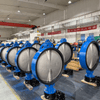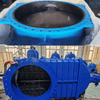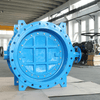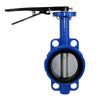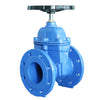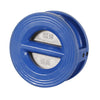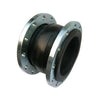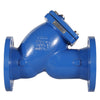How to Choose the Right Check Valve for Your System
Even with an understanding of the various types of check valves, it can still be challenging to select the most suitable one for a specific application, as each model is designed to meet different needs.
This article will describe the common types of check valves and discuss typical selection criteria. These criteria can help narrow down the options and identify the best check valve solution to meet the requirements of a specific application.
- Silent Check Valve
- Ball Check Valve
- Dual Disc Check Valve
- Swing Check Valve
- Tilted Disc Check Valve
Silent Check Valve

Silent check valves are commonly used in high-rise buildings and high-head applications due to their quiet closing characteristics. They consist of a threaded, wafer, or flanged valve body, a corrosion-resistant seat, and a disc with an integrated stem.
When fluid begins to flow, the disc is pushed to the right, allowing forward flow. When the pump stops, a compressed spring inside the valve closes it before the fluid can reverse, ensuring silent closure. With a short linear travel of only one-fourth of the diameter, the silent check valve can close quickly in approximately 0.1 seconds.
However, since the disc is always in the flow path, silent check valves have relatively high head loss and are therefore primarily suited for high-head applications with clean water.
Ball Check Valve

Ball check valves feature a simple and compact design, making them a cost-effective choice for small to medium-sized water pumps or sewage pump systems.
These valves consist of a threaded or flanged body with an internal design that guides a rubber-coated ball to move in and out of the seat with the flow direction. During operation, the ball rolls, providing a degree of self-cleaning capability.
The valve’s top-access maintenance port allows for easy servicing without removing the valve from the pipeline. Ball check valves can be used in water and wastewater systems but are prone to water hammer in high-head applications or parallel pump systems due to the ball’s larger inertia and longer travel distance.
In single-pump and low-head systems, ball check valves generally perform well and offer low head loss.
Dual Disc Check Valve

This valve features a wafer-style design (installed between two pipe flanges) with a hinge pin and two opposing D-shaped discs that rotate around the pin.
Additionally, it includes a component called a stop pin, which centers and stabilizes the discs within the flow path when the valve is fully open.
In practical applications, the valve may experience wear due to vibration, so stabilizing balls should be added at the ends of the hinge pin to prevent vibration. The resilient seat is typically molded directly onto the valve body and the supporting bracket that spans the valve.
Since the bracket is located within the flow path, debris can accumulate, making dual-plate check valves unsuitable for wastewater containing solids.
The valve's flow passage is about 80% of the pipe diameter, so head loss must be considered. Closure is assisted by torsion springs around the hinge pin, which apply force to the backs of the discs, providing excellent water hammer resistance.
Like the check valves mentioned above, this type does not have open/closed position indicators, but thanks to the spring mechanism, it delivers superior water hammer protection.
Swing Check Valve

Swing check valves have historically been the most common type of check valve used in water and wastewater pumping systems.
The name "swing check valve" comes from its design, which typically consists of a valve body and a closure element (or disc) that rotates around a hinge pin. The swing angle is usually between 60 to 90 degrees.
Due to the long travel distance, combined with the inertia of the disc and friction in the packing, this type of valve may experience water hammer issues when used in multi-pump systems or vertical pipe installations.
As a result, these valves are often equipped with various accessories, the most common being a lever and weight.
While it is commonly believed that the weight speeds up valve closure, its primary function is to limit the disc’s travel, thereby reducing water hammer. However, this may significantly increase head loss as a trade-off.
Tilted Disc Check Valve

With a flow area reaching 140% and a disc design similar to that of a butterfly valve, fluid can pass on both sides of the disc, resulting in extremely low head loss.
The tilting disc check valve features a durable aluminum bronze metal seat and offers optional top or bottom-mounted oil dampers. These dampers provide effective valve control and help manage pressure fluctuations in medium-length piping systems.
Like other swing check valves, the tilting disc check valve operates fully automatically, requiring no external power or electrical signals from pump control systems.
Additionally, this valve includes an external position indicator. However, since the hinge pin extends into the flow path and can collect debris, it is suitable only for clean water or treated wastewater systems.
Selection Criteria and Significance of Check Valves
Initial Costs and Maintenance Costs
The purchase cost of various check valves can be easily obtained from local distributors or manufacturers, with prices varying significantly based on functionality and quality.
However, it is important to note that purchase cost represents only a portion of the initial cost, as installation and maintenance costs can sometimes exceed the purchase cost.
Some check valves, such as wafer-style valves, are highly compact but require a straight pipe section upstream that is 3 to 5 times the pipe diameter.
Certain valves may not be suitable for vertical piping, necessitating additional horizontal piping for installation.
Additionally, some types of check valves, as well as most large check valves, require some form of weight support.
In summary, the initial cost of a check valve should account for factors such as its face-to-face length, the required pipe length, installation costs, maintenance costs, and the expense of supporting structures.

Non Slam Characteristics
From the first day of operation, pumping systems are often troubled by check valve slam and the pressure fluctuations it causes in the system.
Check valve slam is a two-step process:
- After the pump stops, fluid flows backward through the check valve while the valve has not yet fully closed.
- The closure element suddenly cuts off the reverse flow.
Therefore, understanding the dynamic closing characteristics of various automatic check valves is crucial. The best way to prevent slam is to ensure the valve closes quickly. So, what factors enable a valve to close rapidly?
1.Position of the Closure Element
If the closure element (e.g., a disc) remains within the flow path (as in silent check valves), reverse flow immediately acts on it, pushing it to close quickly.
If the closure element is outside the flow path (as in ball check valves), reverse flow has less direct impact, resulting in slower closure.
2. Length of the Closing Stroke
The shorter the closure element’s travel distance, the faster the closure. For example:
- Silent check valves and nozzle check valves have a closing stroke of approximately one-quarter of the pipe diameter.
- Ball check valves have a much longer closing stroke, equal to the full pipe diameter.
- In swing check valves, resilient hinge designs close at an angle of just 35 degrees, compared to the 60 to 90 degrees of traditional swing check valves.
3.Weight of the Closure Element
Lighter closure elements respond more quickly to changes in fluid dynamics, while heavier ones require greater force and time to move.
4. Installation Orientation
The non-slam performance of a check valve can be influenced by its installation direction. Regardless of the design, all check valves can be installed in horizontal positions, even if the pipeline is slightly inclined.
However, extra attention is needed for vertical installations:
In upward vertical flow, reverse flow can exacerbate slam issues. With the disc in a vertical plane and no gravitational assistance for closing, increased inertia may cause the disc to be forcefully slammed into the seat by rapid reverse flow, despite lever mechanisms attempting to balance the disc.
For vertical pipe applications, the best choice is a valve with a short linear stroke or one with an inclined seat.

Head Loss and Energy Costs
Head Loss refers to the energy lost by a fluid as it flows through pipelines, valves, or other fittings due to friction, turbulence, and impact. This loss is typically expressed as a pressure drop, leading to increased energy consumption. Head loss is a key performance indicator for check valves.
Cv: Flow Coefficient
Currently, various flow coefficients and head loss formulas are widely used to evaluate the head loss performance of valves. The most common flow coefficient for water valves is the Cv flow coefficient. The higher the Cv value, the more efficient the valve.
Kv: Resistance Coefficient
Another flow coefficient used to assess valve head loss is the Kv resistance coefficient, which is applied in general valve and fitting flow formulas. Kv is a critical parameter that measures the resistance generated as fluid passes through the valve, enabling a more precise evaluation of the valve’s performance and the system’s head loss.
Fluid Compatibility
The type of pipeline medium is a critical factor when selecting a check valve. While all check valves on the market can handle clean water or treated wastewater, many valves become unsuitable when the medium changes from potable water to raw water, sewage, screened sewage, or untreated wastewater.
When selecting a check valve, the following aspects need to be considered:
- Can the valve seat maintain proper sealing if suspended solids are present?
- Are there components such as shafts, stems, spokes, or discs in the flow path? These components may obstruct the passage of solids in the medium.
- Valve body geometry: Are there gaps or areas where solids could accumulate, potentially hindering the normal operation of the valve?
- Bore design: The higher the concentration of suspended solids, the more important a full-bore design becomes to avoid blockages.
If the valve has a straight and smooth flow path, the likelihood of clogging is greatly reduced. Based on these considerations, the following types of check valves are not suitable for wastewater containing high concentrations of solids:
- Nozzle Check Valve
- Silent Check Valve
- Dual Disc Check Valve
- Tilted Disc Check Valve
Understanding the basic selection criteria for check valves is essential for choosing the most suitable type for your fluid system. This plays a crucial role in improving the efficiency of your fluid system.
If you're looking for a reliable and suitable check valve supplier, Union Valve might be your ideal choice. We not only offer a wide variety of standard valves but also provide custom designs to meet your exact specifications. If you have any other questions, please feel free to contact us.
Related Article:
- The Difference Between Check Valve And One-Way Valve
- Choosing the Right Valves for Efficient Water Supply Systems

-
Posted in
Ball Type Check Valve, check valve, Dual Plate Wafer Check Valve, Silent Check Valve, Swing Check Valve, Tilting Check Valve


